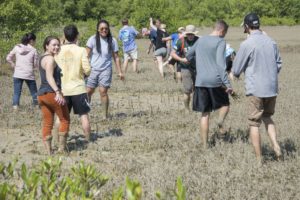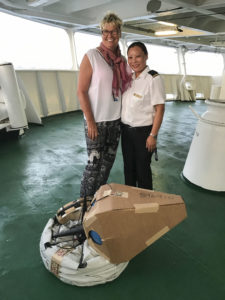Most Forest and Rangeland Stewardship faculty can easily visit the resources they teach about. This is more difficult if you’re Ursula Quillmann. She needs the ocean.
“All my friends would tease me about teaching oceanography in Fort Collins,” she said. “I told them that CSU is going to get me a ship and then Semester at Sea came around the corner.”
Quillmann was one of four Global Teaching Scholars last spring during Colorado State University’s second Semester at Sea voyage as the program’s hosting academic institution. The immersive experience inspired her to develop a new course, “Ocean Dynamics and Carbon Dioxide.” The course fulfills an All University Core Curriculum science requirement and is available to CSU honors students beginning Spring 2018.
The mainland connection
After seeing the imbalance of ocean dynamics and carbon dioxide processes across the globe during the voyage, Quillmann knew it was time to dive deeply into this topic. The new course links the environmental issues she witnessed with the global cycles driving some of the changes. During Semester at Sea, she organized mainland field trips that complemented concepts taught in her Oceanography and Coastal Environmental Ecology classes.
She and her students planted mangrove trees in Vietnam (Agent Orange destroyed many mangrove forests during the Vietnam War); they saw how higher temperatures distressed young, endangered African penguins in South Africa; and they heard how overfishing from international vessels and local pollution afflicted a village in Ghana.

These experiences illustrate both direct and indirect consequences that high concentrations of carbon dioxide in the atmosphere are having on plants, animals and people. Human manufacturing processes and consumption have generated much of this invisible gas for a long period of time, but Quillmann finds that this connection still lacks understanding.
“The physical effects of pollution are easily visible, but with carbon dioxide the effects are more abstract,” she said. “I wanted to demystify the terms and concepts associated with climate change by creating this course. Students should really understand what’s going on and how the environment is dealing with all the additional carbon dioxide.”
Carbon dioxide’s past, present and future
The ocean and climate are intricately linked and these land issues signify a growing vulnerability in the blue foundation that covers more than 70 percent of the Earth’s surface. As the planet’s primary heat and carbon sink, the ocean tempers climate change by absorbing carbon dioxide from the atmosphere. Quillmann’s new course delves into the crucial role these two processes play in climate change.
“Think about a closed soda can in the fridge. As long as there’s a lot of pressure and it’s cold, it can store carbonation which is carbon dioxide,” Quillmann explained. “But if you leave an open soda can on the counter the carbon dioxide fizzes out. The ocean is the same; if the ocean’s surface is warming, the ocean absorbs less carbon dioxide and the atmosphere warms it up even further.”
She further related this effect can also happen if you dilute the soda with water. A comparable phenomenon is currently taking place in the ocean as water from melting ice sheets infuses its top layer. Scientists at the National Oceanic and Atmospheric Administration have been tracking the ocean’s surface through drifting buoys since 1979. They’ve observed recent changes in the currents around South Africa. Warm Indian Ocean surface currents are leaking into the colder Atlantic currents which reduces the ocean’s ability to trap carbon dioxide in its depths.

Along the ship’s route in the southern Hemisphere, Quillmann helped to deploy 31 additional drifters that will help fill system gaps across these two oceans. The instruments are tracking currents, along with changes in their temperature, salinity and other surficial components, and will transmit these data over the next few years. Quillmann looks forward to incorporating these living data in her classroom. She included the latest research in her new course, and will continue to incorporate new information as it’s published.
“There are so many cycles that we should be concerned about but we don’t really have all the answers,” she said. “The scientific community believes there’s a tipping point to how much carbon dioxide the ocean can absorb and we’re accelerating toward that limit.”
After her Semester at Sea experience, Quillmann believes the consequences of crossing this point will be something her students will also see during their lifetime.